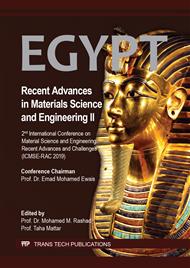[1]
C. Falconi, Piezoelectric nanotransducers, Nano Energy. 59 (2019) 730–744.
DOI: 10.1016/j.nanoen.2019.03.027
Google Scholar
[2]
S.S. Won, J. Lee, V. Venugopal, D. Kim, J. Lee, I.W. Kim, A.I. Kingon, S. Kim, S.S. Won, J. Lee, V. Venugopal, D. Kim, J. Lee, vibrational energy harvester applications, 232908 (2016) 0–5.
DOI: 10.1063/1.4953623
Google Scholar
[3]
A. Uranga, J. Verd, N. Barniol, Microelectronic Engineering CMOS – MEMS resonators : From devices to applications, Microelectron. Eng. 132 (2015) 58–73.
DOI: 10.1016/j.mee.2014.08.015
Google Scholar
[4]
H.J. Kim, Y.J. Kim, High performance flexible piezoelectric pressure sensor based on CNTs-doped 0–3 ceramic-epoxy nanocomposites, Mater. Des. 151 (2018) 133–140.
DOI: 10.1016/j.matdes.2018.04.048
Google Scholar
[5]
T.-R. Hsu, MEMS and Microsystems: Design, Manufacture, and Nanoscale Engineering, John Wiley & Sons, (2008).
Google Scholar
[6]
D. Damjanovic, Ferroelectric, dielectric and piezoelectric properties of ferroelectric thin films and ceramics, Rep. Prog. Phys. 61 (1998) 1267–1324.
DOI: 10.1088/0034-4885/61/9/002
Google Scholar
[7]
F. Guido, M. Teresa, F. Guido, V. Mastronardi, D. Desmaele, G. Epifani, L. Algieri, M.D. Vittorio, Piezoelectric MEMS vibrational energy harvesters : Advances and outlook Microelectronic Engineering Piezoelectric MEMS vibrational energy harvesters : Advances and outlook, Microelectron. Eng. (2017).
DOI: 10.1016/j.mee.2017.10.005
Google Scholar
[8]
C. Chao, Z. Wang, W. Zhu, Measurement of longitudinal piezoelectric coefficient of lead zirconate titanate thin/thick films using a novel scanning Mach-Zehnder interferometer, Thin Solid Films. 493 (2005) 313–318.
DOI: 10.1016/j.tsf.2005.08.005
Google Scholar
[9]
J. Fialka, P. Benes, Comparison of Methods for the Measurement of Piezoelectric Coefficients, IEEE Trans. Instrum. Meas. 62 (2013) 1047–1057.
DOI: 10.1109/tim.2012.2234576
Google Scholar
[10]
G.-T. Park, J.-J. Choi, J. Ryu, H. Fan, H.-J. Kim, Measurement of Piezoelectric Coefficients of Lead Zirconate Titanate Thin Films by Strain-Monitoring Pneumatic Loading Method, 2002.
DOI: 10.1063/1.1487901
Google Scholar
[11]
A. Gomez, M. Gich, A. Carretero-Genevrier, T. Puig, X. Obradors, Piezo-generated charge mapping revealed through direct piezoelectric force microscopy, Nat. Commun. 8 (2017).
DOI: 10.1038/s41467-017-01361-2
Google Scholar
[12]
Q. Guo, G.Z. Cao, I.Y. Shen, Measurements of piezoelectric coefficient d33 of lead zirconate titanate thin films using a mini force hammer, J. Vib. Acoust. 135 (2013) 011003.
DOI: 10.1115/1.4006881
Google Scholar
[13]
J.E.A. Southin, S.A. Wilson, D. Schmitt, R.W. Whatmore, e31, f determination for PZT films using a conventionald33'meter, J. Phys. Appl. Phys. 34 (2001) 1456.
DOI: 10.1088/0022-3727/34/10/303
Google Scholar
[14]
F. Xu, F. Chu, S. Trolier-McKinstry, Longitudinal piezoelectric coefficient measurement for bulk ceramics and thin films using pneumatic pressure rig, 1999.
DOI: 10.1063/1.370771
Google Scholar
[15]
Publication and proposed revision of ANSI/IEEE standard 176-1987 ANSI/IEEE standard on piezoelectricity,, IEEE Trans. Ultrason. Ferroelectr. Freq. Control. 43 (1996) 717–771.
DOI: 10.1109/tuffc.1996.535477
Google Scholar
[16]
Q. Guo, G.Z. Cao, I.Y. Shen, Measurements of Piezoelectric Coefficient d 33 of Lead Zirconate Titanate Thin Films Using a Mini Force Hammer, J. Vib. Acoust. 135 (2013) 011003.
DOI: 10.1115/1.4006881
Google Scholar
[17]
K. Lefki, G.J.M. Dormans, Measurement of piezoelectric coefficients of ferroelectric thin films easurement of piezoelectric coefficients of ferroelectric thin films, 1764 (1994).
DOI: 10.1063/1.357693
Google Scholar
[18]
P.M. Skeen, G. Lucas, R.G. Forbes, M. Caresta, Brüel & Kjær Pulse Labshop Primer, (n.d.) 57.
Google Scholar
[19]
C.A. Gandarilla-Pérez, R. Rodríguez-Ramos, I. Sevostianov, F.J. Sabina, J. Bravo-Castillero, R. Guinovart-Díaz, L. Lau-Alfonso, Extension of Maxwell homogenization scheme for piezoelectric composites containing spheroidal inhomogeneities, Int. J. Solids Struct. 135 (2018) 125–136.
DOI: 10.1016/j.ijsolstr.2017.11.015
Google Scholar
[20]
A. Barzegar, D. Damjanovic, N. Setter, The Effect of Boundary Conditions and Sample Aspect Ratio on Apparent d 33 Piezoelectric Coefficient Determined by Direct Quasistatic, 51 (2004) 262–270.
DOI: 10.1109/tuffc.2004.1295405
Google Scholar
[21]
L. Parali, I. Şabikoʇlu, M.A. Kurbanov, Piezoelectric properties of the new generation active matrix hybrid (micro-nano) composites, Appl. Surf. Sci. 318 (2014) 6–9.
DOI: 10.1016/j.apsusc.2013.10.043
Google Scholar
[22]
H.L.W. Chan, J. Unsworth, Simple Model for Piezoelectric Ceramic/Polymer 1-3 Composites Used in Ultrasonic Transducer Applications, IEEE. 36 (1989) 434–441.
DOI: 10.1109/58.31780
Google Scholar
[23]
L.E.C. R.E. Newnham, D.P. Skinner, Connectivity and piezoelectric-pyroelectric composites, ELSEVIER. 13 (1978) 525–536.
DOI: 10.1016/0025-5408(78)90161-7
Google Scholar
[24]
Z. De-qing, W. Da-wei, Y. Jie, Z. Quan-liang, Structural and Electrical Properties of PZT / PVDF Piezoelectric Nanocomposites Prepared by Cold-Press and Hot-Press Routes *, 25 (2008) 4410–4413.
DOI: 10.1088/0256-307x/25/12/063
Google Scholar
[25]
Z.P. Wang, J.K. Nelson, H. Hillborg, S. Zhao, L.S. Schadler, Dielectric constant and breakdown strength of polymer composites with high aspect ratio fillers studied by finite element models, Compos. Sci. Technol. 76 (2013) 29–36.
DOI: 10.1016/j.compscitech.2012.12.014
Google Scholar
[26]
R. Li, J. Zhou, H. Liu, J. Pei, Effect of Polymer Matrix on the Structure and Electric Properties of Piezoelectric Lead, (2017).
Google Scholar
[27]
I.I. Babu, Piezoelectric composites : design, fabrication and performance analysis, (2013).
Google Scholar


